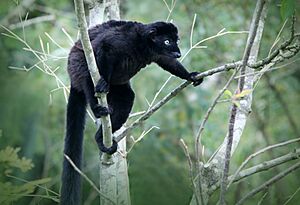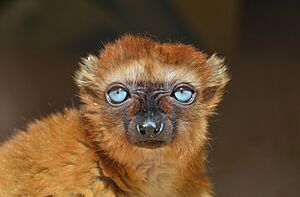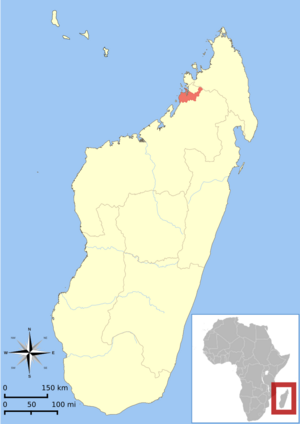Blue-eyed black lemur facts for kids
Quick facts for kids Blue-eyed black lemur |
|
|---|---|
 |
|
| Black-haired male, Bristol Zoo | |
 |
|
| Reddish-brown-haired female | |
| Conservation status | |
| Scientific classification | |
 |
|
| Distribution of E. flavifrons | |
| Synonyms | |
|
The blue-eyed black lemur (Eulemur flavifrons) is a special type of lemur. It's also known as the Sclater's lemur. These amazing animals are one of the few primates, besides humans, that consistently have blue eyes! Their eyes can be bright electric blue, light sky-blue, or a softer gray-blue.
This lemur can grow to be about 39 to 45 centimeters (about 15 to 18 inches) long, not counting its tail. Its tail is even longer, reaching 51 to 65 centimeters (about 20 to 26 inches). In total, they can be 90 to 100 centimeters (about 35 to 39 inches) long. They weigh around 1.8 to 1.9 kilograms (about 4 pounds).
Blue-eyed black lemurs have strong hands, much like human hands. Their palms have a rubbery feel, which helps them grip branches tightly. Their long tail helps them balance, but they can't use it to grab things.
What Do Blue-Eyed Black Lemurs Look Like?
These lemurs are unique because males and females look different. This is called sexual dichromatism.
- Males are completely black. Sometimes, the hairs might have a brownish tint at the roots.
- Females are reddish-brown. Their bellies and the outline of their faces are a lighter tan color. They also have a dark brown or gray snout. The backs of their hands and feet are dark too.
You might confuse them with the black lemur. But the blue-eyed black lemur has blue eyes and no big ear tufts. Black lemurs, on the other hand, have orange-red eyes and long, spiky cheek hairs. Sometimes, these two species might have babies together where their homes overlap. But these babies always have orange eyes. Until 2008, the blue-eyed black lemur was thought to be a type of black lemur.
How Do Blue-Eyed Black Lemurs Behave?
Scientists haven't studied these lemurs a lot in the wild. But we know they are quite social animals. They usually live in groups of four to eleven lemurs. Like most lemur species, the females are in charge. There are usually more males than females in each group.
Lemur Family Life
Female blue-eyed black lemurs usually have one or two babies in June or July. The babies are born after about 120 to 129 days. Young lemurs drink their mother's milk for about 5 to 6 months. They become adults when they are about 2 years old. In zoos, they can live for 15 to 30 years. We don't have much information about how long they live in the wild.
These lemurs are active throughout the day and sometimes at night. Their nighttime activities might depend on how bright the moonlight is.
How Lemurs Communicate
Blue-eyed black lemurs use different ways to talk to each other. They use scent, sounds, and maybe even facial expressions.
- Scent marking is very important for lemurs. Both male and female lemurs rub special glands on trees to leave their scent. Males also use glands on their wrists and palms. They rub and twist them on leaves or branches. Males even have a scent gland on top of their heads. They rub their heads quickly against things to mark them.
- Vocalizations are also used. We don't know much about their calls, but they make grunts, chirps, barks, and clicks. When male lemurs are upset, they make a sharp 'scree' sound.
These lemurs can be quite aggressive. They often fight with other members of their group. This happens more often during the breeding and birthing seasons. In zoos, they have even been seen hurting the babies of other lemur species. This is usually very rare behavior, especially in captivity.
What Do Blue-Eyed Black Lemurs Eat?
Most of what these lemurs eat is fruit, pollen, and nectar.
- During the dry season, when food is hard to find, they might eat leaves, seeds, and berries.
- They rarely eat insects.
- Sometimes, they might go into farms and eat crops. This can cause farmers to shoot them.
Blue-eyed black lemurs are very helpful to the rainforest. When they eat fruit, they digest the fleshy part but not the seeds. They then spread the seeds of over 50 different plant species in their droppings. This helps new plants grow. Some plants might have even evolved to rely on these lemurs to spread their seeds! These lemurs also help pollinate many plants when they eat nectar and pollen from flowers.
Where Do Blue-Eyed Black Lemurs Live?
The blue-eyed black lemur lives in the northwestern part of Madagascar. They prefer moist and dry forests, both old and new. Their home stretches from the Andranomalaza River in the north to the Maevarano River in the south.
You might be able to see them in forests south of Maromandia near Antananarivo and Antsiranana. They can also be found in the remaining forest patches of the Sahamalaza National Park, like the Ankarafa forest.
Why Are Blue-Eyed Black Lemurs Endangered?
Sadly, the blue-eyed black lemur is almost gone from the wild. Humans have cut down most of their home to create farmland.
- This lemur is listed as critically endangered. This means they are at a very high risk of becoming extinct.
- There might be as few as 1,000 of them left in the wild.
- The biggest reason for this is "slash and burn" farming. This is when forests are cut down and burned to clear land for crops.
- Hunting is also a small threat to them.


